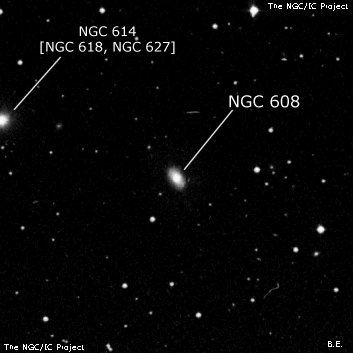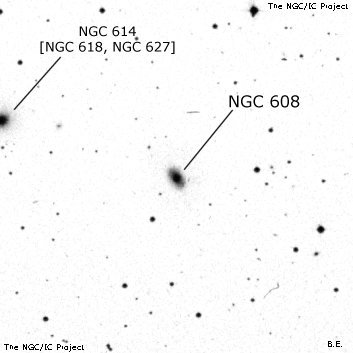NGC/IC Project Restoration Effort
(This is a very very beta version)
NGC618


Basic Information
Location and Magnitude
Right Ascension: 1:41:36.8
Declination: +33:17:42
Constellation: TRI
Visual Magnitude:
Historic Information
Discoverer: Herschel J.
Year of discovery: 1827
Discovery aperture: 18.3
Observational
Summary description: pB, pL, bM (? Place)
Sub-type: *Grp
Corwin's Notes
=====
NGC 618 may be NGC 614 (which is also NGC 627, which see) -- or it may be NGC
608. JH's position points at nothing, and there is no star 2 min 51 sec east
of that position as his description claims. NGC 614 fits his description
("pB, pL, bM") but the fairly bright star follows by only 55 sec. Is there
perhaps a combination of transcription errors and/or typos in JH's offset to
the star? I'm thinking perhaps that the superscript "m" on the 2 in his
description stands for "magnitude" rather than "minute." The star, of
course, is not 2nd magnitude -- this is where the error would have to occur.
Whatever the case, there is certainly an error in JH's position for the
galaxy.
Is his object NGC 608? This is not quite as likely; N608 is the fainter of
the two galaxies in the area. Also, N618 was found during a different sweep
(102) than NGC 608 and NGC 614 (both sweep 106), and different again from N627
(sweep 100), the other "missing" object in the area. I'm tempted to simply
equate N618 with N608, and N627 with N614. But the relative magnitudes, and
the fact that N618 and N627 were found during different sweeps argues in favor
of JH having seen only the brightest object during each sweep.
So, I note the possibility of the identity of N618 with N614 or with N608, but
would not bet my Pentium on it!
-----
Wolfgang has recently (July 2014) looked at the field with JH's observing log
in hand. He suggests instead that NGC 618 is an asterism centered on a bright
star at 01 41 36.8, +33 17 42 (J2000), but I see only a bright (V = 10.1) star
at this position, unlikely to have been mistaken as nebulous. While I've
added this object to the table, I've also added question marks.
-----
Working on a general cleanup of the position file in July 2016, I once again
ran across this object. This time I checked the sweep and found a peculiar
record for this object, number 25 in sweep 102 on 16 November 1827. JH has it
at "-342 beats" and "18' S[outh] of St[ar]." Given that the star is
TYC 2298-44-1 = GSC 02298-00044 = 2MASS J01391229+3341346, this leads to the
position that JH published in his 1833 list and was carried on into the NGC
half a century later.
The "-342 beats" translates into -2minutes 51seconds (2 chronometer beats a
second). It occured to me that perhaps the signs might be wrong. Checking at
the suggested offsets, however, showed no nebulae. Did JH refer his nebula to
a different star, perhaps the double star (WDS J01526+3127AB) that followed
the nebula in the sweep? Again, checking the four possible offsets, I found
no nebulae.
What about the objects that I've suggested as possible identifications? Do
either of these have a star at the correct offset? The answer is "No." This
makes neither NGC 608 nor NGC 614 a reasonable choice. What about Wolfgang's
asterism? Again, there is no star at JH's offsets.
Or NGC 618 could just be a comet. But a search using JPL's "Small Body
Identification" tool, limited roughly to JH's sweep limits in declination and
between RAs of 1hr and 2hrs on his observing date turned up no comets.
So, given that there is nothing on the sky in the area that matches JH's
description and offsets, I have to throw up my hands once again and say,
"Another lost NGC object!"
However, JH adds an interesting footnote at the end of the sweep that may go
some ways toward explaining the situation: "This sweep made with Sir Rufane
Donkin who arrived unexpectedly just as I had begun & staid [sic] the night."
JH goes on to comment on their observations of the Orion Nebula and Rigel
("... which is really superb"), and on the bad weather earlier in the day ("It
had rained hard all day"). Is it possible, I wonder, that the presence of a
distinguished lieutenant general, knighted for service to his king and country
all over the world, and twenty years older than JH, could have perhaps rattled
the younger man a bit? If so, then an extended search for JH's object, with
its offset star, along the belt of sweep might be of some value.



